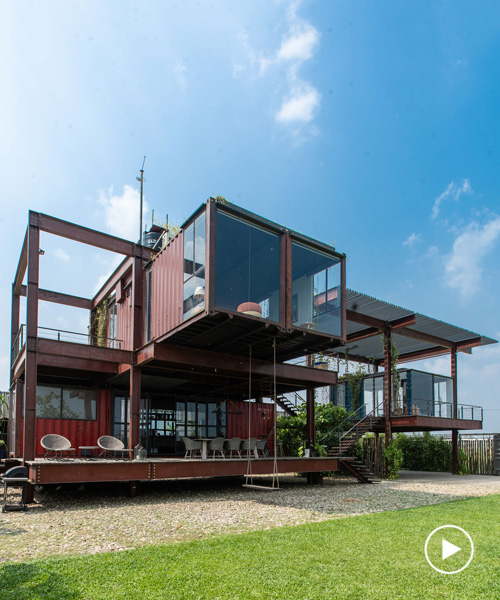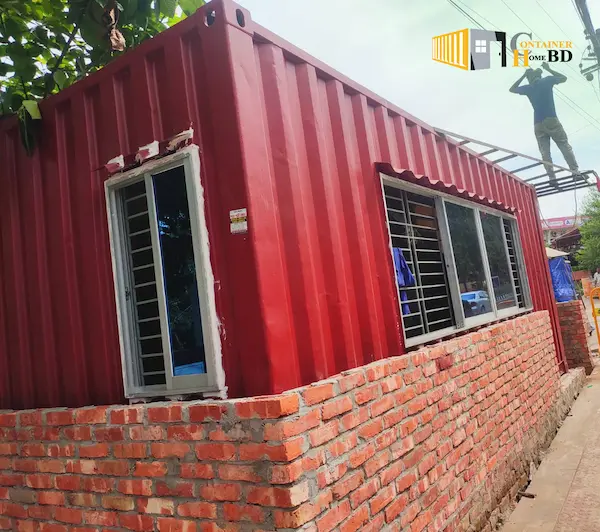Big shipping container homes are gaining popularity in Bangladesh. They offer a modern, eco-friendly housing solution.
In Bangladesh, the concept of using shipping containers as homes is exciting and innovative. These homes are not only stylish but also cost-effective and environmentally friendly. They provide a unique solution to housing problems in urban and rural areas. With the growing interest in sustainable living, shipping container homes present an attractive option.
They are easy to construct, durable, and can be customized to fit various needs. As more people look for affordable and green housing alternatives, big shipping container homes are becoming a trend worth exploring. This blog will delve into the benefits, challenges, and future of these fascinating homes in Bangladesh.
Benefits
Big shipping container homes are becoming popular in Bangladesh. They offer several benefits that make them an attractive option. From cost savings to environmental advantages, these homes provide unique solutions.
Affordability
Shipping container homes are affordable. Traditional homes require expensive materials. In contrast, shipping containers are cheaper. They are available at a lower price. This reduces the overall cost of building. Labor costs are also lower. These homes require less time to construct. This makes them budget-friendly for many families.
Sustainability
Container homes are environmentally friendly. They use recycled materials. This reduces waste and conserves resources. The construction process is also cleaner. It requires less energy. This helps in reducing carbon footprint. These homes are durable. They withstand harsh weather conditions. This means fewer repairs and replacements. Ultimately, they promote a more sustainable lifestyle.

Credit: www.youtube.com
Design
Designing big shipping container homes in Bangladesh offers unique challenges and opportunities. These homes transform steel boxes into comfortable, stylish living spaces. The design process focuses on creativity and practicality. It balances functionality with aesthetic appeal. Each home reflects individual style and needs.
Innovative Layouts
Shipping container homes feature innovative layouts. These layouts maximize space and functionality. Designers often stack containers in unique ways. This creates multi-level homes with ample living space. Open floor plans are common. They enhance natural light and airflow. Clever storage solutions help maintain a clutter-free environment.
Customization Options
Customization is key in container home design. Owners can choose from various finishes and materials. Wall finishes, flooring, and fixtures can match personal preferences. Exterior designs can include decks, patios, and gardens. These elements enhance outdoor living. Roof designs can support solar panels or green roofs. Such features contribute to sustainability.
Construction
Construction of big shipping container homes in Bangladesh is gaining popularity. These homes are affordable, eco-friendly, and quick to build. They offer a unique living experience, blending modern design with sustainability. The construction process is efficient, making these homes an attractive option for many.
Building Process
The building process begins with selecting suitable shipping containers. These containers are then transported to the construction site. Next, the containers are cleaned and inspected for any damage. Once they are ready, the containers are cut and modified according to the design plan.
After modification, the containers are placed on a foundation. This foundation can be a concrete slab or metal stilts. The containers are then welded together to ensure stability. Openings for doors and windows are created. Finally, insulation and interior finishes are added to complete the home.
Materials Used
Shipping containers are the primary material used in construction. These steel containers provide a strong and durable structure. Insulation materials, such as foam panels or spray foam, are used to maintain a comfortable temperature inside.
Other materials include metal reinforcements, plywood for flooring, and drywall for interior walls. Windows and doors are made from energy-efficient materials. Exterior finishes can vary, including paint, wood cladding, or metal panels. Each material is chosen for its durability and sustainability.
Cost
Building big shipping container homes in Bangladesh offers an affordable solution. Construction costs are lower compared to traditional homes. Utilizing recycled materials further reduces expenses, making it budget-friendly.
When considering building a big shipping container home in Bangladesh, understanding the cost is crucial. Container homes are gaining popularity for their affordability, but how much do they really cost? Let’s delve into the details and see what you can expect financially when investing in a container home.Initial Investment
The initial investment is often more affordable compared to traditional homes. A standard shipping container can cost anywhere from $2,000 to $5,000 depending on size and condition. You will need multiple containers for a big home, so calculate accordingly. Don’t forget to factor in costs for land, permits, and professional services like architects or engineers. Consider the cost of modifications. Insulation, plumbing, and electrical installations are necessary and will add to your budget.Long-term Savings
Once built, container homes can offer significant long-term savings. They are often more energy-efficient due to their compact design, which can reduce your utility bills. Maintenance costs are typically lower. Steel containers are durable and require less upkeep than traditional materials like wood or brick. Think about the potential for resale value. The trend of sustainable living is growing, which might increase the future value of your container home. In my experience, choosing a container home led to unexpected savings. The reduced energy bills allowed me to allocate funds toward other life goals. Could your choice of home impact your financial freedom? Whether you’re looking for an affordable initial investment or long-term savings, shipping container homes in Bangladesh offer a compelling option. What are your thoughts on investing in a sustainable and cost-effective home?Challenges
Building big shipping container homes in Bangladesh can be a thrilling venture, but it’s not without its challenges. These homes offer a unique blend of sustainability and modern design, yet they come with obstacles that demand attention. From navigating complex regulations to dealing with the country’s weather, each hurdle requires careful planning and execution.
Regulatory Hurdles
Regulations in Bangladesh can be tricky, especially for unconventional structures like shipping container homes. You might face challenges in acquiring permits or adhering to construction codes. I remember a friend struggling with paperwork for months because his design didn’t fit the typical housing mold. This can be frustrating, but understanding local laws and engaging with the right authorities can pave the way for a smoother process.
Weather Considerations
Bangladesh’s climate poses its own set of challenges. The monsoon season is particularly daunting, as heavy rains can affect construction timelines and structural integrity. You need to think about insulation and drainage solutions to ensure your container home withstands the elements. A well-planned drainage system can prevent water logging during heavy rains, preserving your investment and peace of mind.
As you delve into the world of shipping container homes, ask yourself: Are you prepared to tackle these challenges head-on? With careful planning and the right approach, you can transform these obstacles into opportunities for innovation and growth. Are you ready to take the leap?
Case Studies
The use of shipping containers as homes has gained significant attention in Bangladesh. These innovative structures offer a sustainable and affordable housing solution. Let’s dive into some real-life examples where shipping container homes have been successfully implemented in Bangladesh.
Successful Projects
Several initiatives have transformed shipping containers into beautiful living spaces in Bangladesh. A notable example is the “Container Living Project” in Dhaka. This project turned old containers into eco-friendly homes, providing affordable housing options for the city’s growing population.
Another success story is a community-driven effort in Chittagong. Here, multiple families collaborated to create a small neighborhood using shipping containers. The project not only provided shelter but also fostered a sense of community among the residents.
These projects highlight the potential of shipping container homes in urban and rural settings. They demonstrate that with creativity and planning, you can transform basic containers into comfortable, aesthetically pleasing homes.
Lessons Learned
Throughout these projects, several valuable lessons emerged. One major insight was the importance of insulation. Containers can become extremely hot in Bangladesh’s climate, so proper insulation is crucial for comfort.
Another lesson was the necessity of community involvement. Projects that engaged local communities from the start saw better acceptance and success. Could your neighborhood be next in embracing this sustainable trend?
Lastly, the choice of materials for modifications proved vital. Durable and locally available materials ensured the longevity and affordability of the homes. What materials around you could be repurposed for such innovative housing?
These insights offer practical guidance for anyone considering container homes. They show that with careful planning and community engagement, you can turn these metal boxes into warm, welcoming homes.
Future Prospects
Big shipping container homes in Bangladesh hold promising future prospects. As urban spaces shrink, alternative housing solutions gain attention. Shipping container homes offer an innovative approach. These homes provide cost-effective and sustainable living spaces. Let’s explore the growth potential and innovations in this field.
Growth Potential
The demand for affordable housing in Bangladesh is rising. Shipping container homes present a viable solution. These homes utilize available resources effectively. Their modular nature allows for quick construction. This appeals to urban developers and homeowners alike. As awareness grows, more individuals consider this option. Container homes can address housing shortages efficiently. They also cater to eco-friendly living preferences.
Innovations
Innovations in container home designs are expanding. Architects experiment with creative layouts and features. Solar panels and rainwater harvesting are becoming standard. These technologies enhance sustainability. Interior designs now prioritize comfort and aesthetics. Some homes integrate smart technology for modern living. Recycled materials contribute to unique and stylish finishes. Innovations make container homes a smart choice for future living. They blend functionality with environmental responsibility.

Credit: www.prefabcontainerhomes.org

Credit: www.designboom.com
Frequently Asked Questions
What Is The Price Of 20 Feet Used Container In Bangladesh?
A 20 feet used container in Bangladesh costs between $1,500 and $2,500, depending on condition and location. Prices may vary due to demand and supply factors.
How Much Is A 2000 Sq Ft Container Home?
A 2000 sq ft container home typically costs between $100,000 and $300,000. Prices vary based on design and location.
What Is The Price Of 40 Feet Container In Bangladesh?
The price of a 40 feet container in Bangladesh typically ranges from $3,000 to $6,000. Prices vary based on condition, location, and supplier. For the most accurate pricing, contact local suppliers or check online marketplaces.
What Is The Largest Shipping Container Home?
The largest shipping container home is the “Maison Container Project” in France. It uses eight containers, covering 2,240 square feet. This innovative design showcases the potential of sustainable and spacious living using recycled materials. The home features modern amenities and stylish interiors, offering a unique living experience.
Conclusion
Big shipping container homes offer many benefits in Bangladesh. They are affordable and quick to build. These homes use eco-friendly materials, helping the environment. Families find them stylish and modern. Container homes fit well in urban areas, saving space. They can withstand harsh weather, providing safety.
With smart design, they meet different needs. These homes represent a practical solution for housing. They blend innovation with sustainability. As interest grows, container homes will likely become more popular. Bangladesh can benefit from embracing this trend. A promising future for housing awaits.
